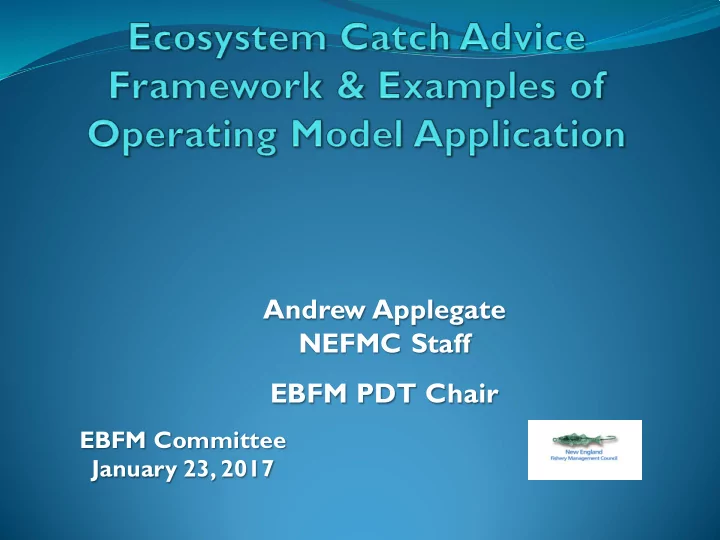

Andrew Applegate NEFMC Staff EBFM PDT Chair EBFM Committee January 23, 2017
EBFM PDT • Andrew Applegate, NEFMC staff • Dr. Peter Auster, Dept. Marine Sci, U. Conn. • Dr. Rich Bell, The Nature Conservancy • Tim Cardiasmenos, NEPA Policy Analyst, GARFO • Dr. Kiersten Curti, NEFSC Population Dynamics Branch • Dr. Geret DePiper, NEFSC Social Sciences Branch • Dr. Gavin Fay, Dept. Fisheries, U. Mass Dartmouth • Dr. Michael Fogarty, NEFSC Ecosystem Assessment Program • Ashton Harp, Fish and Habitat biologist (ASMFC) • Dr. Sean Lucey, NEFSC Ecosystem Assessment Program • Dr. Daniel Palmer, Protected Resources, GARFO • Rich Seagraves, MAFMC staff • Dr. David Stevenson, Habitat Conservation, GARFO 2
Today’s presentation • Respond to request and issues raised • Explain framework for providing ecosystem catch advice • Demonstrate HCR worked examples using an operating model • Discuss how it fits into an eFEP and how it can be used for MSE to develop management policy 4
Committee guidance to focus eFEP development on the following steps: 1. Describe a trophic web area based operating model that specifies: an ecosystem area species present in the area that will be dynamically model species present in the area that will be treated as externalities (they participate in the food web, but their numbers and biomass is determined outside the model- e.g., mammals, birds, most benthic invertebrates) feeding models that account for preference, suitability and availability matrix of production attributable to ecosystem area (incorporating seasonality) stochastic nature of these relationships- could use Bayesian approach 5
Committee guidance to focus eFEP development on the following steps: 2. Test alternative approaches to management including: current single species approach guild (trophic level) approach Total ecosystem productivity approach 3. For each approach, specify (worked examples): criteria for overfishing rebuilding strategy mechanism to protect most targeted or vulnerable stocks (min, biomass, but not necessarily linked to BMSY) 6
Draft Operational Framework Sep 2016 (http://s3.amazonaws.com/nefmc.org/1c.-Draft-Operational-Frameowrk-and-Operational-Models-to-Support-Fishery-Ecoysstem-Plan-Development.pdf) • Ecosystem simulation models • Hydra – 10 species length-structured model with trophic interactions • Ecosym/Ecopath (EwE) – mass-balance energy flow • Atlantis – end-to-end with physical and biological processes • Operating model • Combination of above models to provide strategic advice and guidance • Operational Framework • Operating model • Management Strategy Evaluation process • Assessments to provide tactical advice • Functional groups and EPU catch cap • Overfishing definition • Overfished/depleted definition 7
Ecosystem Catch Advice Framework • Overall catch cap based on system energetics • Derived from satellite-based measures of primary production • Allowance for diversions to microbial loop and non-fished species 8
Ecosystem Catch Advice Framework • Catch limits defined for stock complexes • Not to exceed the EPU catch cap • Minimum biomass thresholds to protect species from depletion • Measures to prevent too much catch of highly-valued vulnerable, less-resilient species • Catch limits balanced to achieve multiple objectives 9
10
Operating Model (OM) example • Example application of harvest control rules (HCRs) • Demonstration of how OMs could be used to evaluate alternatives management strategies • Performance metrics and multiple objectives 11
Operating Model (OM) example • OM: Hydra • 10 species on Georges Bank • Majority of commercial catch • Species having parameterized trophic interactions 12
Interaction strength Stock complex – group related species at a defined trophic level. Functional group – Intersection of stock complexes with a fishery, i.e. they are caught together. 13
Example HCRs • Constant mortality – three alternative levels • Hockey stick with alternative minimum biomass thresholds 14
Constant mortality, three levels F ramped by complex Scaled biomass and catch Proportion of runs exceeding threshold Catch lower & fewer runs above biomass threshold at F=0.3 Thresholdand F ramping improved performance at F=0.3 15
F ramped by species Constant mortality, three levels Proportion of runs exceeding threshold (generally 20%B 0 ) More risk at F=0.3, particularly for dogfish, herring, cod, mackerel, and yellowtail flounder. F ramp applied to complex when a stock is below its threshold. 16
Balancing variation in revenue Portfolio analysis 17
Domestic commercial landings 18
Total commercial landings 19
Commercial Catch 20
NEFMC Approach • To prepare: 1. A policy describing goals and objectives, and approaches, for taking account of ecosystem processes in fishery management, and 2. An example of a fishery ecosystem plan that is based on fundamental properties of ecosystem (e.g., energy flow and predator/prey interactions) as well as being realistic enough and with enough specification such that it could be implemented. The example should not be unduly constrained by current perceptions about legal restrictions or policies. 21
NEFMC Process • To prepare: 3. With respect to number 2, it is understood that the example might not be implemented, but it should make clear what a fishery ecosystem plan would actually entail and it should focus debate. To the extent practicable, these documents should be completed in about one year. In consideration of these documents, the Council will adopt a plan for implementation. The EBFM PDT will have the technical lead in developing these documents and the EBFM committee will recommend the documents for Council consideration. 22
FEP C oncept • Place based approach • Ecosystem cap based on primary productivity • Catch limits by stock complex (functional group) 23
FEP S tructure • Catch control rules • Stock complex specifications • Species specifications or other conservation measures when overfished and/or valuable or vulnerable 24
FEP E lements • Goals and objectives • Ecological overfishing thresholds • Species depletion/ecosystem risk • Ecological habitat consideration and spatial management • Access to fisheries • Coordination by management bodies 25
FEP T echnolgy • Realistic operating models to support strategic decision-making • Compatible assessments for tactical decision-making • Management Strategy Evaluation – to be developed, Phase III 26
MSE loop – Holland (2010) 27
MSE loop – Punt et al. 2016 28
MSE loop – EBFM PDT 29
Performance metrics and tradeoffs (from Punt et al. 2016) 30
Recommend
More recommend